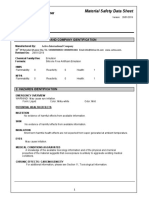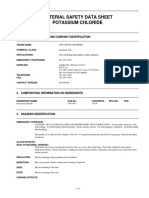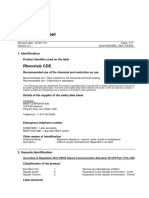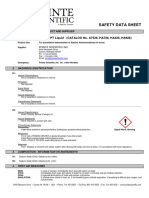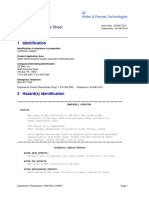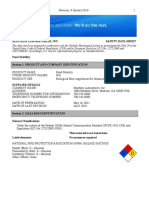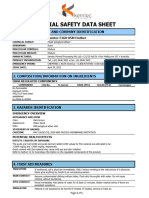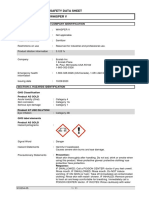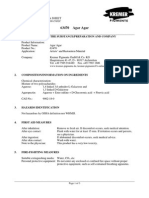Gripe Water
Gripe Water
Uploaded by
kashif.employmenthoursCopyright:
Available Formats
Gripe Water
Gripe Water
Uploaded by
kashif.employmenthoursOriginal Title
Copyright
Available Formats
Share this document
Did you find this document useful?
Is this content inappropriate?
Copyright:
Available Formats
Gripe Water
Gripe Water
Uploaded by
kashif.employmenthoursCopyright:
Available Formats
Employment Hours
Material Safety Data Sheet
Gripe Water
1. CHEMICAL PRODUCT AND COMPANY IDENTIFICATION
PRODUCT NAME: Gripe Water
OTHER/GENERIC NAMES:
PRODUCT USE: Solvent, Cleaning Agent
MANUFACTURER: Honeywell, Burdick & Jackson
1953 South Harvey Street
Muskegon, MI 49442
FOR MORE INFORMATION CALL: IN CASE OF EMERGENCY CALL:
(Monday-Friday, 8:00am-5:00pm) (24 Hours/ Day, 7 Days/ Week)
1-800-368-0050 1-800-707-4555 or Chemtrec 1-800-424-9300
2. COMPOSITION/INFORMATION ON INGREDIENTS
INGREDIENT NAME CAS NUMBER WEIGHT %
Water 7732-18-5 100
Trace impurities and additional material names not listed above may also appear in Section 15 toward the end of the
MSDS. These materials may be listed for local "Right-To-Know" compliance and for other reasons.
3. HAZARDS IDENTIFICATION
EMERGENCY OVERVIEW:
This material is not hazardous under normal handling and storage conditions. When
heated to boiling, steam and liquid contact can cause burns to skin and mucous
membranes. Not for medical or pyrogen- free use. Not intended for human consumption.
POTENTIAL HEALTH HAZARDS
SKIN: Prolonged exposure may cause dryness
EYES: May cause tearing and blurred vision.
INHALATION: Inhalation of liquid or vapor can cause shortness of breath, and in extreme deluge
circumstances, drowning may occur.
INGESTION: While this material is not reported, or expected to be specifically toxic, ingestion may cause other
toxins to be introduced (carried) into the body. Do not drink!
DELAYED EFFECTS: Prolonged exposure to liquid or vapor may lead to symptoms of pneumonia.
MSDS Number: 0365 Current Page 1 of 7
Issue Date: June, 2023
Employment Hours
MATERIAL SAFETY DATA SHEET
Water
Ingredients found on one of the OSHA designated carcinogen lists are listed below.
INGREDIENT NAME NTP STATUS IARC STATUS OSHA LIST
No ingredients listed in this section.
4. FIRST AID MEASURES
SKIN: Wash affected area with mild soap and water and rinse area until no evidence of chemical
remains.
EYES: Rinse eyes with plenty of water or normal saline solution for at least 15 minutes
INHALATION: Remove from exposure area to fresh air. If victim is not breathing administer artificial respiration
according to your level of training and obtain professional medical assistance immediately
INGESTION: Do not induce vomiting unless instructed to do so by a physician.
ADVICE TO PHYSICIAN: No specific antidote. Treat symptomatically and supportively.
5. FIRE FIGHTING MEASURES
FLAMMABLE PROPERTIES
FLASH POINT: Not applicable
FLASH POINT METHOD: Not applicable
AUTOIGNITION TEMPERATURE: Not applicable
UPPER FLAME LIMIT (volume % in air): Not applicable
LOWER FLAME LIMIT (volume % in air): Not applicable
FLAME PROPAGATION RATE (solids): Not applicable
OSHA FLAMMABILITY CLASS: Not applicable
EXTINGUISHING MEDIA:
Not applicable
UNUSUAL FIRE AND EXPLOSION HAZARDS:
Closed containers may pressurize and explode under fire conditions.
SPECIAL FIRE FIGHTING PRECAUTIONS/INSTRUCTIONS:
Water spray will not be effective as a fire fighting agent, but may be useful in cooling containers or structure
components that are adjacent to involved material.
MSDS Number: 0365 Page 2 of 7
Current Issue Date: June, 2000
Employment Hours
MATERIAL SAFETY DATA SHEET
Water
6. ACCIDENTAL RELEASE MEASURES
IN CASE OF SPILL OR OTHER RELEASE: (Always wear recommended personal protective equipment.)
Isolate the spill area. Stop leak in a safe and practical manner. (If leak cannot be stopped easily and safely, advise
trained emergency response personnel of the situation.) Using inert material (such as ground corncobs) dike the
spilled solvent to prevent it from running into drains or waterways, so as not to carry other harmful material that
may be present in spill area to waterways.
Spills and releases may have to be reported to Federal and/or local authorities. See Section 15 regarding reporting
requirements.
7. HANDLING AND STORAGE
NORMAL HANDLING: (Always wear recommended personal protective equipment.)
Keep container closed.
Protective gloves and apron are recommended .
STORAGE RECOMMENDATIONS:
Protect from temperature extremes and sunlight, and store away from incompatible substances .. Avoid acids,
bases, oxidizers, and explosives.
8. EXPOSURE CONTROLS/PERSONAL PROTECTION
ENGINEERING CONTROLS:
Provide general or local exhaust ventilation systems as appropriate. (Local exhaust ventilation is preferred because
it prevents contaminant dispersion into the work area by controlling it at its source.
PERSONAL PROTECTIVE EQUIPMENT
SKIN PROTECTION:
Where liquid contact is possible impervious coveralls are recommended. To minimize the possibility in other
handling and storage operations, wear appropriate PPE to include chemical resistant gloves, boots and apron.
EYE PROTECTION:
Wear protective eyeglasses (with side shields), chemical goggles alone or in conjunction with full face shield.
Follow OSHA regulation 29CFR 1910.133.
(Contact lenses are not protective devices.)
RESPIRATORY PROTECTION:
Seek professional advice prior to respirator selection and use. Follow OSHA respirator regulations ( 29 CFR
1910.134) and, if necessary, wear a MSHA/ NIOSH-approved respirator. For emergency or non-routine operations
(cleaning spills, reactor vessels, or storage tanks), wear an SCBA. Warning! Air-purifying respirators do not
protect workers in oxygen-deficient atmospheres.
MSDS Number: 0365 Page 3 of 7
Current Issue Date: June, 2000
Employment Hours
MATERIAL SAFETY DATA SHEET
Water
ADDITIONAL RECOMMENDATIONS:
This material should be used in close proximity to eyewash station and safety shower. Use appropriate
personal hygiene after handling this material. Do not smoke in the vicinity of flammable materials.
EXPOSURE GUIDELINES
INGREDIENT NAME ACGIH TLV OSHA PEL OTHER LIMIT
No ingredients listed in this section.
* = Limit established by Honeywell International, Inc.
** = Workplace Environmental Exposure Level (AIHA).
*** = Biological Exposure Index (ACGIH).
OTHER EXPOSURE LIMITS FOR POTENTIAL DECOMPOSITION PRODUCTS:
None
9. PHYSICAL AND CHEMICAL PROPERTIES
APPEARANCE: Colorless
PHYSICAL STATE: Liquid (Clear)
MOLECULAR WEIGHT: 18.02
CHEMICAL FORMULA: H 2O
ODOR: Odorless
SPECIFIC GRAVITY (water = 1.0): 0.9982 g/ ml @ 20 º
SOLUBILITY IN WATER (weight %): Not Applicable
pH: ~7.0
BOILING POINT: 100ºC (212ºF)
MELTING POINT: 0ºC (32ºF)
VAPOR PRESSURE: 17.54 Torr @ 20 ºC
VAPOR DENSITY (air = 1.0): 0.46
EVAPORATION RATE: Not Determined
% VOLATILES: Not Applicable
FLASH POINT: Not Applicable
(Flash point method and additional flammability data are found in Section 5.)
10. STABILITY AND REACTIVITY
NORMALLY STABLE? (CONDITIONS TO AVOID):
Stable at room temperatures in closed containers under normal and recommended storage and use conditions.
MSDS Number: 0365 Page 4 of 7
Current Issue Date: June, 2000
Employment Hours
MATERIAL SAFETY DATA SHEET
Water
INCOMPATIBILITIES:
Organometallics such as phosphorous and sodium metal, strong oxidizers, alkalis and acids.
CONDITIONS TO AVOID:
Avoid freezing conditions. Overheated containers can rupture violently and be propelled great distances in a fire
situation.
HAZARDOUS DECOMPOSITION PRODUCTS:
None known.
HAZARDOUS POLYMERIZATION:
Not expected to occur.
11. TOXICOLOGICAL INFORMATION
IMMEDIATE (ACUTE) EFFECTS:
Not determined
DELAYED (SUBCHRONIC AND CHRONIC) EFFECTS:
None determined
OTHER DATA:
None
12. ECOLOGICAL INFORMATION
Insufficient Data
13. DISPOSAL CONSIDERATIONS
RCRA
Is the unused product a RCRA hazardous waste if discarded? NO
If yes, the RCRA ID number is:
OTHER DISPOSAL CONSIDERATIONS:
Dispose of material in accordance with all applicable local, state, and federal regulations.
The information offered here is for the product as shipped. Use and/ or alterations to the product such as mixing
with other materials may significantly change the characteristics of the material and alter the RCRA classification
and the proper disposal method.
14. TRANSPORT INFORMATION
US DOT PROPER SHIPPING NAME: Not Applicable
US DOT HAZARD CLASS: Not Applicable
MSDS Number: 0365 Page 5 of 7
Current Issue Date: June, 2000
Employment Hours
MATERIAL SAFETY DATA SHEET
Water
US DOT ID NUMBER: Not Applicable
US DOT PACKING GROUP: Not Applicable
NA EMERGENCY RESPONSE GUIDE: Not Applicable
For additional information on shipping regulations affecting this material, contact the information number found in
Section 1.
15. REGULATORY INFORMATION
TOXIC SUBSTANCES CONTROL ACT (TSCA)
TSCA INVENTORY STATUS: Not Applicable
OTHER TSCA ISSUES: None
SARA TITLE III/CERCLA
"Reportable Quantities" (RQs) and/ or "Threshold Planning Quantities" (TPQs) exist for the following ingredients.
INGREDIENT NAME SARA/CERCLA RQ (lb) SARA EHS TPQ (lb)
No ingredients listed in this section.
Spills or releases resulting in the loss of any ingredient at or above its RQ requires immediate notification to
the National Response Center [(800) 424-8802] and to your Local Emergency Planning Committee.
SECTION 311 HAZARD CLASS: None
SARA 313 TOXIC CHEMICALS :
The following ingredients are SARA 313 "Toxic Chemicals". CAS numbers and weight percents are found in
Section 2.
INGREDIENT NAME COMMENT
No ingredients listed in this section
STATE RIGHT-TO-KNOW
In addition to the ingredients found in Section 2, the following are listed for state right-to-know purposes.
INGREDIENT NAME WEIGHT % COMMENT
No ingredients listed in this section
ADDITIONAL REGULATORY INFORMATION:
None
MSDS Number: 0365 Page 6 of 7
Current Issue Date: June, 2000
Employment Hours
MATERIAL SAFETY DATA SHEET
Water
WHMIS CLASSIFICATION (CANADA):
FOREIGN INVENTORY STATUS:
16. OTHER INFORMATION
CURRENT ISSUE DATE: June, 2023
PREVIOUS ISSUE DATE: April, 1996, January, 2000
CHANGES TO MSDS FROM PREVIOUS ISSUE DATE ARE DUE TO THE FOLLOWING:
Update to ANSI Standard. New header and footer information.
OTHER INFORMATION :
NFPA Classification
Health: 0
Flammability: 0
Reactivity: 0
MSDS Number: 0365 Page 7 of 7
Current Issue Date: June, 2000
You might also like
- GMW 3359 Non Electrolytically Applied Zinc Rich Coating 2 1 14 PDFDocument9 pagesGMW 3359 Non Electrolytically Applied Zinc Rich Coating 2 1 14 PDFjoaopedrosousa0% (1)
- BuffersolDocument10 pagesBuffersolArdyas Wisnu BaskoroNo ratings yet
- Seachem Laboratories, Inc. Safety Data SheetDocument9 pagesSeachem Laboratories, Inc. Safety Data SheetJorge Restrepo HernandezNo ratings yet
- Jenway 6310 Service Manual PDFDocument84 pagesJenway 6310 Service Manual PDFArdo IsküllNo ratings yet
- MSDS Dross AluminiumDocument18 pagesMSDS Dross AluminiumNurul muzayyanahNo ratings yet
- Material Safety Data Sheet: Burdick & Jackson Burdick & JacksonDocument7 pagesMaterial Safety Data Sheet: Burdick & Jackson Burdick & JacksonFahad AhmedNo ratings yet
- Material Safety Data Sheet: Sodium SulfiteDocument6 pagesMaterial Safety Data Sheet: Sodium Sulfiteeng20072007No ratings yet
- Kemtec-F140-Frother-MSDS-r02Document5 pagesKemtec-F140-Frother-MSDS-r02Usman NiazNo ratings yet
- Safety Data SheetDocument6 pagesSafety Data Sheetepitrade2020No ratings yet
- Activa Fast Defoamer FD 4050W MSDS - New-PDF-11!5!19Document7 pagesActiva Fast Defoamer FD 4050W MSDS - New-PDF-11!5!19محمد صبحيNo ratings yet
- MSDS Potassium ChlorideDocument6 pagesMSDS Potassium ChlorideokiNo ratings yet
- MSDS Data TrayDocument4 pagesMSDS Data TrayIkhwan FikriNo ratings yet
- Potassium - Fluorotitanate - Materials Safety Data SheetDocument7 pagesPotassium - Fluorotitanate - Materials Safety Data SheetMahmood KhanNo ratings yet
- Seachem Laboratories, Inc. Safety Data SheetDocument8 pagesSeachem Laboratories, Inc. Safety Data SheetJorge Restrepo HernandezNo ratings yet
- Polyurethane Seam Sealant R53827 SDS 1191831Document4 pagesPolyurethane Seam Sealant R53827 SDS 1191831Brahian Payano MatosNo ratings yet
- Material Safety Data Sheet: F-29, Liquid SanitizerDocument4 pagesMaterial Safety Data Sheet: F-29, Liquid SanitizerNiraNo ratings yet
- AL2-7 Grease PDFDocument4 pagesAL2-7 Grease PDFtrung vothaiNo ratings yet
- TQ FYwpsu HR 4 U KIi W5 Zjo H06 S WDDD 3 MQ4 LM Ceghg 4Document11 pagesTQ FYwpsu HR 4 U KIi W5 Zjo H06 S WDDD 3 MQ4 LM Ceghg 4Muhammad AslamNo ratings yet
- Seachem Laboratories, Inc. Safety Data SheetDocument8 pagesSeachem Laboratories, Inc. Safety Data SheetJorge Restrepo HernandezNo ratings yet
- Desco 660 GHSDocument4 pagesDesco 660 GHSpemping1No ratings yet
- Material Safety Data Sheet: 1 IdentificationDocument6 pagesMaterial Safety Data Sheet: 1 IdentificationManuel PerezNo ratings yet
- SDS - Dispex® AA 4144Document9 pagesSDS - Dispex® AA 4144Özlem YılmazNo ratings yet
- SDS Rheovis CDEDocument11 pagesSDS Rheovis CDEanacaroline.carvalhoNo ratings yet
- Safety Data Sheet: Section 1. IdentificationDocument6 pagesSafety Data Sheet: Section 1. IdentificationOswaldo Manuel Ramirez MarinNo ratings yet
- Ep 204 2ehDocument8 pagesEp 204 2ehxibs2009No ratings yet
- Seachem Laboratories, Inc. Safety Data SheetDocument8 pagesSeachem Laboratories, Inc. Safety Data SheetJorge Restrepo HernandezNo ratings yet
- Scalebreak-SS MAR 13Document2 pagesScalebreak-SS MAR 13dalton2004No ratings yet
- Nikken Mark X Fountain SolutionDocument2 pagesNikken Mark X Fountain Solutionsolusi.grafikaNo ratings yet
- Frick 55 Gallon Refrigeration Oil 11Document4 pagesFrick 55 Gallon Refrigeration Oil 11ANDRESNo ratings yet
- Seachem Laboratories, Inc. Safety Data SheetDocument8 pagesSeachem Laboratories, Inc. Safety Data SheetJorge Restrepo HernandezNo ratings yet
- Seachem Laboratories, Inc. Safety Data SheetDocument8 pagesSeachem Laboratories, Inc. Safety Data SheetJorge Restrepo HernandezNo ratings yet
- FDS Grasa Negra Chemola en InglesDocument4 pagesFDS Grasa Negra Chemola en InglespaolamartinezasesoraNo ratings yet
- SDS AlbuminaDocument3 pagesSDS AlbuminaiglesianazreyNo ratings yet
- MSDS CleaningDocument3 pagesMSDS CleaningdavidNo ratings yet
- Seachem Laboratories, Inc. Safety Data SheetDocument9 pagesSeachem Laboratories, Inc. Safety Data SheetJorge Restrepo HernandezNo ratings yet
- Material Safety Data Sheet: 1 IdentificationDocument6 pagesMaterial Safety Data Sheet: 1 IdentificationM PrakashNo ratings yet
- MSDS REFINED OIL - InternationalDocument4 pagesMSDS REFINED OIL - Internationalrizal bestNo ratings yet
- Seachem Laboratories, Inc. Safety Data SheetDocument9 pagesSeachem Laboratories, Inc. Safety Data SheetJorge Restrepo HernandezNo ratings yet
- 39 390124347 883010rbcdilutingfluid (Hayems) MSDS PDFDocument6 pages39 390124347 883010rbcdilutingfluid (Hayems) MSDS PDFryujinNo ratings yet
- Aquatower 170Document6 pagesAquatower 170Diego y MagelaNo ratings yet
- Material Safety Data Sheet: 1. Identification of The Substance/Preparation and The Company/UndertakingDocument4 pagesMaterial Safety Data Sheet: 1. Identification of The Substance/Preparation and The Company/Undertakingtonio28No ratings yet
- (MSDS) Organic Prickly Pear Seed Oil - Natural Sourcing, LLCDocument4 pages(MSDS) Organic Prickly Pear Seed Oil - Natural Sourcing, LLCMohsen MalekiNo ratings yet
- Safety Data Sheet: in Case of EmergencyDocument4 pagesSafety Data Sheet: in Case of EmergencyJose Gilberto Cortez HernandezNo ratings yet
- Safety Data Sheet: 901 Janesville Ave. Fort Atkinson, WI 53538-0901 Phone: 920-563-2446Document2 pagesSafety Data Sheet: 901 Janesville Ave. Fort Atkinson, WI 53538-0901 Phone: 920-563-2446FalihNo ratings yet
- SDS AltDocument3 pagesSDS AltiglesianazreyNo ratings yet
- Material Safety Data Sheet: UltimaDocument4 pagesMaterial Safety Data Sheet: UltimaLubrication´s RoomNo ratings yet
- Sds Solest 120 NLDocument4 pagesSds Solest 120 NLK B ManoharanNo ratings yet
- Safety Data Sheet: 1. IdentificationDocument6 pagesSafety Data Sheet: 1. IdentificationdsdNo ratings yet
- CU3630SS GHSUnitedStatesSDS en 2017-04-17Document9 pagesCU3630SS GHSUnitedStatesSDS en 2017-04-17hann48209No ratings yet
- Seachem Laboratories, Inc. Safety Data SheetDocument9 pagesSeachem Laboratories, Inc. Safety Data SheetJorge Restrepo HernandezNo ratings yet
- Seachem Laboratories, Inc. Safety Data SheetDocument8 pagesSeachem Laboratories, Inc. Safety Data SheetJorge Restrepo HernandezNo ratings yet
- HS Superfloc A-120hmwDocument11 pagesHS Superfloc A-120hmwpatriciatoros88No ratings yet
- Acetic AcidDocument10 pagesAcetic AcidSunder Tukaram KelkarNo ratings yet
- Oxygen ScavengerDocument6 pagesOxygen ScavengerfaridNo ratings yet
- Seachem Laboratories, Inc. Safety Data SheetDocument8 pagesSeachem Laboratories, Inc. Safety Data SheetJorge Restrepo HernandezNo ratings yet
- MSDS 192 Chain, Open Gear & Wire Rope LubeDocument4 pagesMSDS 192 Chain, Open Gear & Wire Rope LubeAldiNo ratings yet
- Seachem Laboratories, Inc. Safety Data SheetDocument8 pagesSeachem Laboratories, Inc. Safety Data SheetJorge Restrepo HernandezNo ratings yet
- Kemtec-F160-05-Frother-MSDS-r03Document5 pagesKemtec-F160-05-Frother-MSDS-r03Usman NiazNo ratings yet
- Msds Rambo 360 SUK MSDS 20160119Document3 pagesMsds Rambo 360 SUK MSDS 20160119Ahmad AndiNo ratings yet
- SDS Hand Sanitizer JOHNSONDocument8 pagesSDS Hand Sanitizer JOHNSONEfson Sustera IrawanNo ratings yet
- Acetalde MSDSDocument5 pagesAcetalde MSDSJaymit PatelNo ratings yet
- Liquid Lanolin: Material Safety Data SheetDocument3 pagesLiquid Lanolin: Material Safety Data SheetIsha Life SciencesNo ratings yet
- TDS SteelMaster 1200WF GB English ProtectiveDocument5 pagesTDS SteelMaster 1200WF GB English Protective폴로 쥰 차No ratings yet
- MSDS of SilymarinDocument6 pagesMSDS of SilymarinDaryl Barrios LamedaNo ratings yet
- Mechanical Integrity Exchanger Tube BundleDocument9 pagesMechanical Integrity Exchanger Tube BundleirvansyahNo ratings yet
- MSDS CCKDocument3 pagesMSDS CCKcustcare1.karyaterangNo ratings yet
- Msds Methylene ChlorideDocument5 pagesMsds Methylene ChlorideLathifa Aisyah AnisNo ratings yet
- b2230 Boysen Epoxy Primer GrayDocument9 pagesb2230 Boysen Epoxy Primer Graydep_vinNo ratings yet
- HDS TurbochefDocument188 pagesHDS TurbochefElvira Ramos SalayaNo ratings yet
- DC200 Silicone Fluid 100CS - MSDSDocument6 pagesDC200 Silicone Fluid 100CS - MSDSRaghavendra MurthyNo ratings yet
- SDS LLC Preston Antifreeze Coolant Premixed YA956-P50Document6 pagesSDS LLC Preston Antifreeze Coolant Premixed YA956-P50loi nguyen vanNo ratings yet
- Dowtherm J Heat Transfer Fluid MSDSDocument9 pagesDowtherm J Heat Transfer Fluid MSDSNoviyanto Dwi NNo ratings yet
- Msds Whisper VDocument11 pagesMsds Whisper VEndri SudrajatNo ratings yet
- HazCom 4Document27 pagesHazCom 4Syafiq KhalilNo ratings yet
- Baracor 100 MSDSDocument2 pagesBaracor 100 MSDSnw5kt744qb100% (1)
- IT Essentials v60 Chapter 2 Introduction To Lab Procedures and Tool UseDocument6 pagesIT Essentials v60 Chapter 2 Introduction To Lab Procedures and Tool UseArif D'SpitFire Panji KusumoNo ratings yet
- General Facility Safety Inspection Checklist PageDocument5 pagesGeneral Facility Safety Inspection Checklist Pagee cubeNo ratings yet
- 533EDocument2 pages533EAlma RujanacNo ratings yet
- Agar - Varnostni ListDocument3 pagesAgar - Varnostni ListIljuha9No ratings yet
- Lab Practical 1 - Laboratory Safety and Techniques - NT10402 Analytical Chemistry (UPDATED)Document20 pagesLab Practical 1 - Laboratory Safety and Techniques - NT10402 Analytical Chemistry (UPDATED)samiputu82No ratings yet
- SDS AkzoNobelDocument16 pagesSDS AkzoNobelOviedo RocíoNo ratings yet
- MSDS, Chromium Trioxide CrystalsDocument9 pagesMSDS, Chromium Trioxide CrystalsNikesh ShahNo ratings yet
- EN710 Anti-Rust Version MSDS SheetDocument6 pagesEN710 Anti-Rust Version MSDS SheetSvetlanaNo ratings yet
- IWAYS (IKEA Requirements)Document8 pagesIWAYS (IKEA Requirements)lawrencesongNo ratings yet
- Msds-Neu-024 Tip - Top Svs VulcDocument9 pagesMsds-Neu-024 Tip - Top Svs Vulcseguridadneuma2023No ratings yet
- LoadingUnloading Activity SWMSDocument7 pagesLoadingUnloading Activity SWMSVaibhav GaikwadNo ratings yet
- Synozol Yellow Hf-4gl (Eng)Document6 pagesSynozol Yellow Hf-4gl (Eng)Jomar OroscoNo ratings yet
- MSDS (NaOH)Document2 pagesMSDS (NaOH)Junko TsukudaNo ratings yet
- Checklist 10.1: Heat Exchanger: Company Facility Location Persons Interviewed Name Title DateDocument5 pagesChecklist 10.1: Heat Exchanger: Company Facility Location Persons Interviewed Name Title DateHandika Muhammad PrabuNo ratings yet









